
Monstera is a genus of 59 species of flowering plants in the arum family, Araceae, native to tropical regions of the Americas.

Ipomoea tuberculata is a flowering plant species in the bindweed family (Convolvulaceae). It belongs to the morning glory genus, Ipomoea.

Rodgersia is a genus of flowering plants in the Saxifragaceae family. Rodgersia are herbaceous perennials originating from east Asia.

Xanthorrhoea australis, the grass tree or austral grasstree, is an Australian plant. It is the most commonly seen species of the genus Xanthorrhoea. Its trunk can grow up to several metres tall and is often branched. In certain Aboriginal languages, it is called bukkup, baggup or kawee.
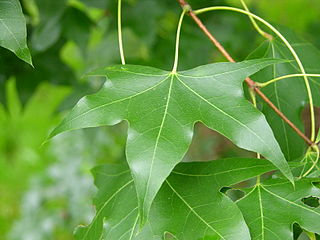
Acer truncatum, the Shantung maple, Shandong maple, or purpleblow maple, is a maple native to northern China, in the provinces of Gansu, Hebei, Henan, Jiangsu, Jilin, Liaoning, Inner Mongolia, Shaanxi, Shandong, Shanxi, and to Korea.

Echinacea atrorubens, called the Topeka purple coneflower, is a North American species of flowering plant in the family Asteraceae. It is native to eastern Kansas, Oklahoma, and eastern Texas in the south-central United States. It is found growing in dry soils around limestone or sandstone outcroppings and prairies.

Echinacea simulata, commonly called wavy leaf purple coneflower, glade coneflower, or prairie purple coneflower, is a species of perennial flowering plant in the family Asteraceae. It is native to the east-central states of the United States. Its natural habitat is dry, calcareous, open areas such as barrens and woodlands.

Livistona tahanensis is a species of medium-sized palm tree of the genus Livistona, found on only one mountain top in Pahang, Peninsular Malaysia. In Malay the palm is known as Tahan serdang, or as daun tau.
Schoepfia harrisii is a species of flowering plant in the Schoepfiaceae family. It is a small tree or shrub, growing two to five metres tall. It is endemic to Jamaica, where it is only known to occur in the parishes of Trelawny and Clarendon, in what is known as Cockpit Country, a region of many steep, rounded, limestone hills, shaped like an egg-carton. Here it grows on crags in moist woodland, between 600 and 900m in elevation.

Annona senegalensis, commonly known as African custard-apple, wild custard apple, wild soursop, abo ibobo, sunkungo, and dorgot is a species of flowering plant in the custard apple family, Annonaceae. The specific epithet, senegalensis, translates to mean "of Senegal", the country where the type specimen was collected.
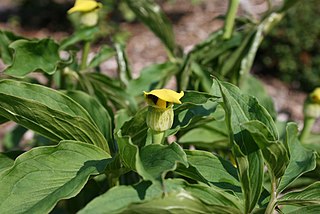
Arisaema flavum is a species of flowering plant widespread across north-eastern Africa and southern Asia. It is native to Ethiopia, Somalia, the Arabian Peninsula, Pakistan, Afghanistan, Nepal, Assam, Himalayas, Tibet, Yunnan, and Sichuan. The species epithet flavum is Latin for yellow and indicates its flower colour.

Arisaema erubescens is a flowering plant species in the genus Arisaema, endemic to Nepal.
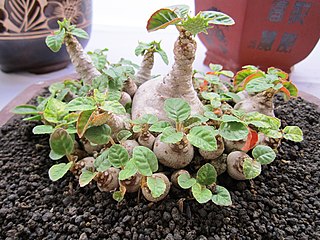
Dorstenia foetida, also known as grendelion, is a succulent plant in the genus Dorstenia, which is native to Eastern Africa and Arabia. It is a very variable species with a wide distribution.
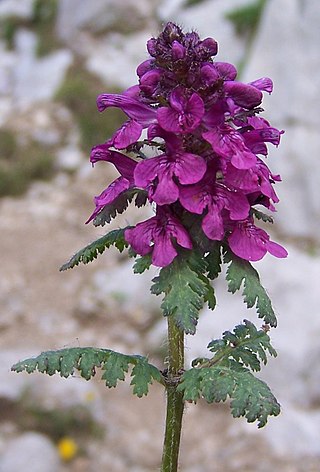
Pedicularis verticillata, the whorled lousewort, is a species of flowering plant in the family Orobanchaceae which can be found in Alaska, North-Western Canada, and everywhere in China at the elevation of 2,100–4,400 metres (6,900–14,400 ft). Its native habitats include moist meadows and lakeshores.

Crassula ovata, commonly known as jade plant, lucky plant, money plant or money tree, is a succulent plant with small pink or white flowers that is native to the KwaZulu-Natal and Eastern Cape provinces of South Africa, and Mozambique; it is common as a houseplant worldwide. Much of its popularity stems from the low levels of care needed; the jade plant requires little water and can survive in most indoor conditions. It is sometimes referred to as the money tree; however, Pachira aquatica also has this nickname.
Pterostylis nigricans, commonly known as the dark greenhood, is a species of orchid endemic to eastern Australia. As with similar orchids, the flowering plants differ from those which are not flowering. The non-flowering plants have a rosette of leaves but the flowering plants lack a rosette at the base but have up to six tiny green, white and brown flowers which have a rough texture.

Andesanthus lepidotus, synonym Tibouchina lepidota, also known as alstonville, Andean princess flower, lasiandra, or glory bush, is a medium-sized ornamental tree or a large shrub native to northwestern South America that is cultivated for its masses of purple flowers from autumn right through to winter.
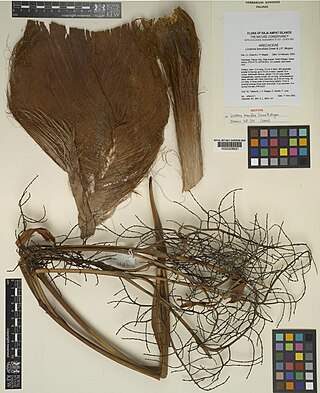
Saribus brevifolius is a species of palm tree in the genus Saribus, which has only been found in the Kawe and Gag Islands in the archipelago of the Raja Ampat Islands, which lie off the north-west tip of the Bird's Head Peninsula in Indonesia's West Papua province. It was only discovered in 2002 during an expedition funded by The Nature Conservancy. The palm grows along the coasts of these two tropical islands on small ridges composed of ultrabasic rock. It is a moderately-sized fan palm with smallish and regularly segmented leaves and a smallish inflorescence in the crown. The inflorescence is not longer than the leaves, and split at its base into three main branches with one or more sub-inflorescences, these containing red flowers with pink anthers. The ends of S. brevifolius leaf segments are rigid and have a bifurcate cleft 1-4% of the segment length.
Monstera juliusii is a flowering plant in the family Araceae. It is native to high-altitude cloud forests of Costa Rica at altitudes of 1,600 to 2,250 metres and occasionally confused with Monstera standleyana. However, M. standleyana has green petioles, few fenestrations and thin leaves, while M. juliusii is characterized by mottled white petioles, frequent fenestrations at maturity and thick, leathery leaves. Mature plants have pinnatilobed leaves as long as 60 cm and 30 cm wide, with circular fenestrations close to the margins, and oval fenestrations near the midrib. The species is named after Julius Johnson, son of the artists Rashid Johnson and Sheree Hovsepian.
Monstera alfaroi is a flowering plant in the arum family. It is endemic to mid-altitude premontane rainforests of Costa Rica at altitudes of 1,100 to 1,250 metres. M. alfaroi features light brown petioles with black or white warts. It is closely related to Monstera buseyi, but M. alfaroi can be distinguished by its larger inflorescence. M. alfaroi is also easily confused with M. costaricensis, which can be distinguished from M. alfaroi by its petioles with white pustules, more conical inflorescence, and location; M. costaricensis only occurs in lowland areas of Costa Rica below 600 metres (2,000 ft). Mature plants have ovate leaf blades as long as 90 centimetres (35 in) and 45 centimetres (18 in) wide, with few circular fenestrations near the midrib. From petiole to blade tip, M. alfaroi leaves can be up to 160 centimetres (63 in) long. It has a white spadix and an externally light green spathe. Flowering has been recorded in November, and fruiting in January.
















